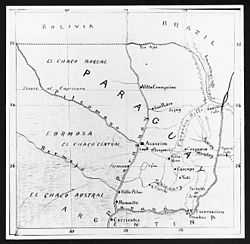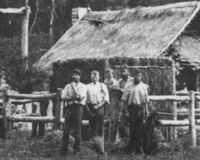New Australia

New Australia was a utopian socialist settlement in Paraguay founded by the Australian New Australian Movement. The colony was officially founded on 28 September 1893 as Colonia Nueva Australia and comprised 238 adults and children.[1]
History
The New Australia Co-operative Settlement Association, known in short as the New Australia Movement, was founded by William Lane in 1892. Lane was a prominent figure in the Australian labour movement and had founded Australia's first labour newspaper – the Queensland Worker in 1890. A split in the Australian labour movement between those who went on to form the Australian Labor Party spurred Lane's intent to found a socialist utopia outside Australia. Lane's ideal[2] was to build a society based on:
- A common-hold, rather than a common-wealth
- A brotherhood of English-speaking Whites
- Life marriage
- Preservation of the 'Colour-Line'
- Teetotalism
- Communism
His concept of 'common-hold' was that each member of a society should be able to withdraw their proportion of the society's wealth if they chose to leave.
Lane's was not the only influence urging Australians at the time towards a socialist community; utopian Edward Bellamy's Looking Backward was also popular with socialists and led many urban followers of Lane to expect that they would live in luxury in a socialist commune like that of Bellamy's fiction.
Paraguay was chosen as the site of the settlement. Lane recruited many, and the first ship left Sydney in July 1893 for Paraguay, where the government was keen to get white settlers and had offered the group a large area of good land. While it is generally agreed that there were some able settlers, there seems to be some disagreement about the character of the New Australia settlers as a whole. It has been described as a Cave of Adullam to misfits, failures, and malcontents of the left wing of Australian democracy.[3] Notable Australian individuals who joined the colony included Mary Gilmore, Rose Summerfield, and Gilbert Stephen Casey. But according to Mr. M.de C.Findlay, the Second Secretary of the Legation at Buenos Aires, who was sent to the colony by the British Consul at Asunction, they were, "a fine class of men." [4] Men were required to pay a minimum of £60 (but including all their assets) to join the colony, a sum large enough in 1893 Australia to usually require the selling of a home, so complete failures would have been necessarily excluded.
The founding of the settlement was of interest to left-wing thinkers worldwide; of the settlement Peter Kropotkin said,
The fact that men and women, who have made Australia what it is, are compelled to migrate from it, speaks volumes in itself. 'Make the land, be the dung which renders it productive, build the centres of civilisation which render it valuable – and go away!' That is the true picture of modern capitalist management. The same here, the same at the antipodes – always the same![5]

There was conflict amongst the settlers from the beginning over prohibition of alcohol, relations with the locals and Lane's leadership, "I can't help feeling that the movement cannot result in success if that incompetent man Lane continues to mismanage so utterly as he has done up to the present," wrote colonist Tom Westwood.[6] Problems intensified after a second group of colonists arrived in 1894. Dissension caused a rift in the colony and in May 1894, Lane and 58 others left New Australia to found Cosme, a new colony 72 kilometres farther south. Eventually New Australia was dissolved as a cooperative by the government of Paraguay, and each settler was given their own piece of land.[3]
Some colonists founded communes elsewhere in Paraguay, others went home to Australia or on to England; some 2000 descendants of the New Australia colonists still live in Paraguay.[6][7][8]
The 1997 book Paradise Mislaid [9] by Anne Whitehead is about the colonists and their descendants today. There is also a fictional retelling of the story by Michael Wilding, called The Paraguayan Experiment.[10] The classic account is historian Gavin Souter's A Peculiar People, written in 1968.[11]
From time to time Australian tourists visit Nueva Australia and make contact with locals, or visit the local school. The town had about 300 residents in 2007, and is only a few hours' bus ride from Iguazu Falls.
References in popular culture
The Melbourne-based Australian Folk Punk band The Currency have a song called "Paraguay" which tells the story of New Australia.
Graeme Connors, Australian country singer-songwriter, wrote a song called "Boomerang in Paradise", a nostalgic, sympathetic retelling of William Lane and the New Australia colonists.
The Weddings Parties Anything song "Drifted Away" is also about the New Australia experiment.
The title track to the 1980 Redgum album Virgin Ground is also about the New Australia Colony.
The group was mentioned by Monte Reel in his article "Welcome to Paradise" in Outside magazine.
Personalities
- William Lane (1861–1917, founder, journalist)
- Gilbert Casey (1856-1946, co-founder, chief of police)
- Robin Wood (b. 1944, comics writer)
See also
References
- ↑ "Cosme and New Australia colonies". National Library of Australia. Retrieved 2006-07-27.
- ↑ Cosme Monthly, June 1895
- ↑ 3.0 3.1 Australian Encyclopaedia Volume 2, p 191, Angus and Robertson Limited, 1926
- ↑ Grahame, Stewart (1912). Where Socialism Failed: an Actual Experiment. London: John Murry. p. 106. ISBN 978-1165791873.
- ↑ "Kropotkin, Peter (1892–1921)".
- ↑ 6.0 6.1 "Trouble in Paraguay". ANU Reporter. Spring 2004.
- ↑ Eric Campbell (September 26, 2006). "Paraguay Aussies". Final Story, Series 16, Episode 12 (ABC Television).
- ↑ Paraguay Aussies - Peru. Journeyman Pictures / ABC. September 26, 2006.
- ↑ Anne Whitehead (1997) Paradise Mislaid – in Search of the Australian Tribe of Paraguay. University of Queensland Press, St. Lucia, Queensland. ISBN 0-7022-2651-3
- ↑ Michael Wilding (1984)The Paraguayan Experiment. Penguin Books, Ringwood Victoria. ISBN 0-14-007360-4
- ↑ Gavin Souter (1968) A peculiar people: The Australians in Paraguay. Angus and Robertson, Sydney. ISBN 0-207-95037-7
Further reading
- A Peculiar People – Souter, Gavin – 1968
- Paradise Mislaid – Whitehead, Anne – 1997.
- "THE "NEW AUSTRALIA" SETTLEMENT IN PARAGUAY.". The Brisbane Courier (Qld. : 1864 - 1933) (Qld.: National Library of Australia). 4 July 1893. p. 6. Retrieved 2 August 2011.